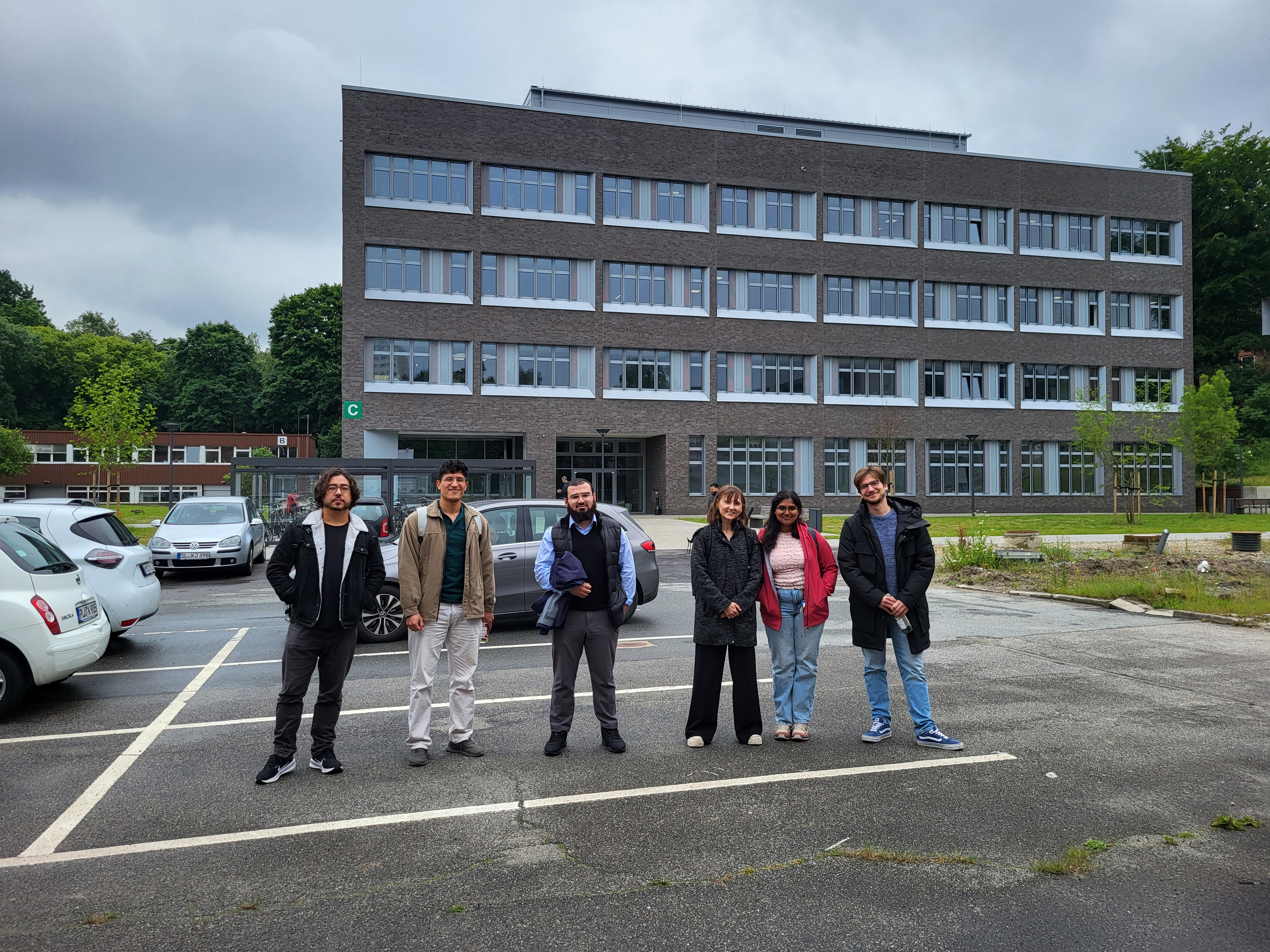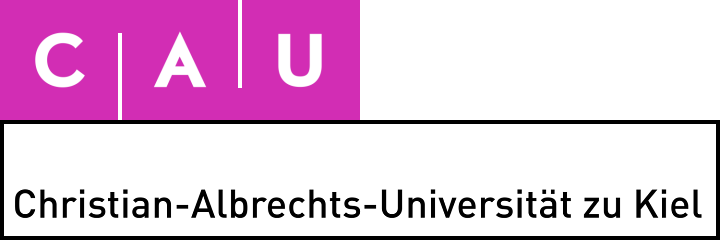Third Onboarding Day at CRC 1261 (10.06.2025)
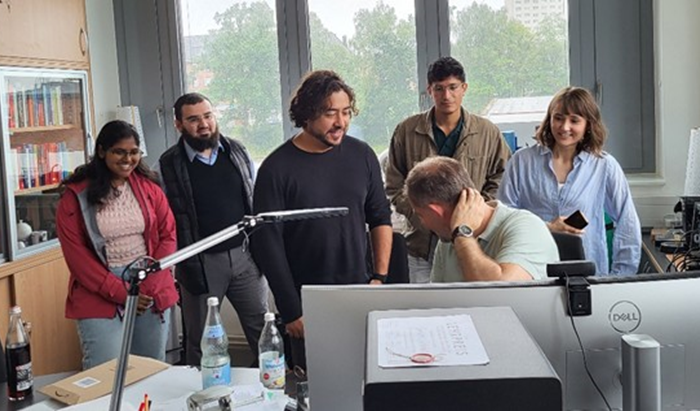 At the start of the onboarding session, there was a shared sense of nervousness as we gradually assembled in the seminar room. Most of us were unfamiliar with one another, connected only by a common factor: we were all, to varying degrees, new researchers within SFB1261. Prof. Gerhard Schmidt (spokesperson of the CRC) offered us coffee and, together with Mona Stölting (Scientific Coordinator), lightened the atmosphere with casual conversation and friendly questions, so we began to feel more at ease.
At the start of the onboarding session, there was a shared sense of nervousness as we gradually assembled in the seminar room. Most of us were unfamiliar with one another, connected only by a common factor: we were all, to varying degrees, new researchers within SFB1261. Prof. Gerhard Schmidt (spokesperson of the CRC) offered us coffee and, together with Mona Stölting (Scientific Coordinator), lightened the atmosphere with casual conversation and friendly questions, so we began to feel more at ease.
The onboarding session was designed to provide a structured introduction to the CRC, laying the groundwork for our integration into the collaborative environment. Over the course of the day, we received a comprehensive overview of the center’s organizational structure, research objectives, and available resources and opportunities.
Getting to know the program
We began the morning with an introductory session covering the motivation and objectives of the CRC, as well as an overview of both completed and planned research projects. Particular focus was given to different types of sensors and their applications, especially in the medical field.
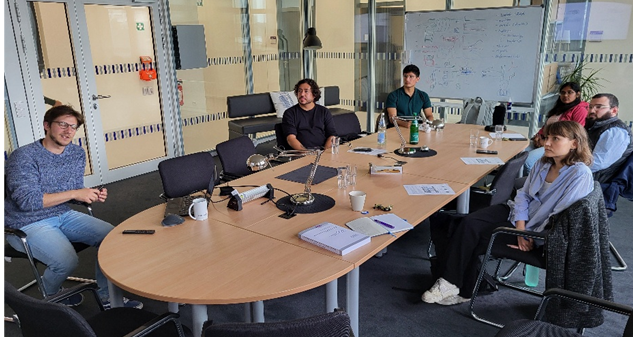 Prof. Gerhard Schmidt presented an overview of the CRC 1261, including its organizational structure, projects, and vision. He went into specific topics, such as Magnetoelectric Sensor Systems for Cardiologic Applications, explaining how cardiac arrhythmias can be treated through the precise localization of affected tissue. Using magnetic sensing, this mapping can be performed non-invasively, eliminating the need for catheter-based procedures. He also introduced the project Bioinspired Nanocomposites for Early Detection of Complications in Gastrointestinal Surgery, outlining how anastomotic leakages can be diagnosed using specific biomarkers. When combined with magnetic nanoparticles, these biomarkers exhibit a distinct response under magnetic fields, which is detected by sensor systems to confirm their presence. The presentation was highly informative, as Prof. Schmidt explored technical details often omitted in general overviews. These scientific insights not only enriched the understanding of the projects but also served to spark greater interest among new collaborators within the CRC.
Prof. Gerhard Schmidt presented an overview of the CRC 1261, including its organizational structure, projects, and vision. He went into specific topics, such as Magnetoelectric Sensor Systems for Cardiologic Applications, explaining how cardiac arrhythmias can be treated through the precise localization of affected tissue. Using magnetic sensing, this mapping can be performed non-invasively, eliminating the need for catheter-based procedures. He also introduced the project Bioinspired Nanocomposites for Early Detection of Complications in Gastrointestinal Surgery, outlining how anastomotic leakages can be diagnosed using specific biomarkers. When combined with magnetic nanoparticles, these biomarkers exhibit a distinct response under magnetic fields, which is detected by sensor systems to confirm their presence. The presentation was highly informative, as Prof. Schmidt explored technical details often omitted in general overviews. These scientific insights not only enriched the understanding of the projects but also served to spark greater interest among new collaborators within the CRC.
Following this, Mona provided us with a highly informative overview of the CRC program structure. Her presentation introduced us to the wide range of available programs and courses. Key milestones for our PhD projects were also outlined, including scheduled meetings with our supervisors.
As part of the outreach segment, Paul Benjamin Diemel gave us an engaging insight into both the CRC’s outreach activities and his own doctoral research topic. He provided valuable insights into different approaches to data collection with a nice interactive survey about “extremely important topics” like the cuteness of baby beavers and made us understand the importance of outreach within the CRC.
We, the onboarding candidates:
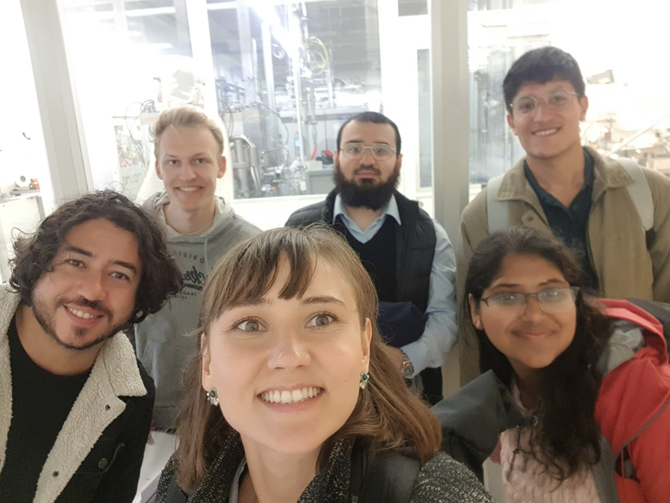
Front row, from left to right: Otto Carlos Lippmann, Eline Reger, Rishita Ghosh. Back row, from left to right: Felix Weisheit, Ari A. Ahmad, Luciano Cendra.
Otto Carlos Lippmann is doing his PhD at CAU as part of the CRC in the project A6. He has a strong love for animals and plays football regularly in weekly matches at DESY in Hamburg. Originally, he is from Brazil, where he completed his B. Eng. in Electronic Engineering and his M.Sc. in Experimental Physics. He was drawn to the SFB by its truly multidisciplinary environment, where researchers from diverse backgrounds bring unique skills and perspectives. For him, the collaborative atmosphere is both inspiring and motivating, offering constant opportunities to learn and grow. This dynamic atmosphere he finds exciting and motivating and genuinely reflects the spirit of a collaborative research center.
Even though he wasn´t entirely new to the project, he was hoping to receive a kind of “everything you need to know” package from the onboarding day, to help him get started more confidently. He says about the day: “It was very interesting to learn more in detail about some projects I hadn’t had the chance to explore yet. For example, the presentation on Early Detection of Complications in Gastrointestinal Surgery was particularly informative. I also found the presentation about the IRTG very interesting, especially as it introduced aspects of the program, such as international exchange opportunities, that I wasn’t previously aware of.”
Eline Reger holds an M.Sc. in Nanotechnology and joined the A9 project as a doctoral researcher where she will try to optimize SAW-sensors by implementing phononic crystals She conducted her master’s thesis on SAWs at the ChyN in Hamburg and is excited about continuing her research in this field within SFB1261.
The overview of the CRC program and the wide range of opportunities, such as external research stays, were particularly helpful.
Rishita Ghosh is part of the CRC as a RISE-DAAD Summer Research Intern.
Ari A. Ahmad did his B.Sc. and M.Sc. in Materials Science and Business Administration in Kiel University and is currently a doctoral researcher at the Chair of Energy Materials and Devices in Project A4.
He says: “I really enjoyed the CRC 1261 onboarding day. It was a valuable opportunity to get to know the people behind the projects and to understand how the different research areas and connect with each other. My motivation to join the CRC was rooted in its interdisciplinary approach and strong collaboration culture. The onboarding day confirmed that this is the right environment to engage in impactful research while exchanging ideas across disciplines.”
One of the key takeaways for him was gaining a much clearer sense of the CRC's broader mission, especially how the research contributes to solving real-world problems through smart sensor systems. It became more evident how our work can have a meaningful impact on society, from health monitoring to industrial applications. He appreciated the open and engaging atmosphere, which made it easy to connect with fellow researchers and see the bigger picture of our collective goals.
Luciano Cendra is an electronics engineering student at Tecnológico de Costa Rica with experience on test systems and aiming to focus his career on digital communications and FPGA prototyping. He joined the CRC with the expectation to collaborate with researchers of different fields and contribute on the research of medical technology.
To him it was motivating to investigate the work of the CRC teams during the onboarding and discussing their project goals and challenges which gave him a valuable insight into everyday work.
Exploring Labs and Meeting the Team:
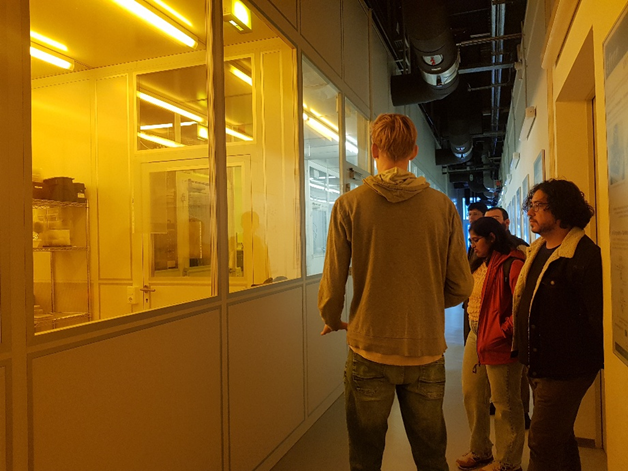 After a shared lunch at the “Dockside” cafeteria, lab tours were planed for us. Several CRC members kindly introduced us to their research topics and guided us through their laboratories, including a visit to the cleanroom facilities.
After a shared lunch at the “Dockside” cafeteria, lab tours were planed for us. Several CRC members kindly introduced us to their research topics and guided us through their laboratories, including a visit to the cleanroom facilities.
Moritz Boueke presented his project on Digital Signal Processing. He demonstrated how an array of 3D sensors, or 3D probes are used to map intestinal motility. The setup involves a wireless capsule that scans the patient's gastrointestinal tract, enabling non-invasive diagnostics. He explained how the sensor system's outputs are processed using digital signal processing techniques, allowing data from multiple sensors to be translated into precise localization information. The presentation highlighted the integration of analogue system design, practical medical applications, and digital processing, resulting in a coordinated sensor array.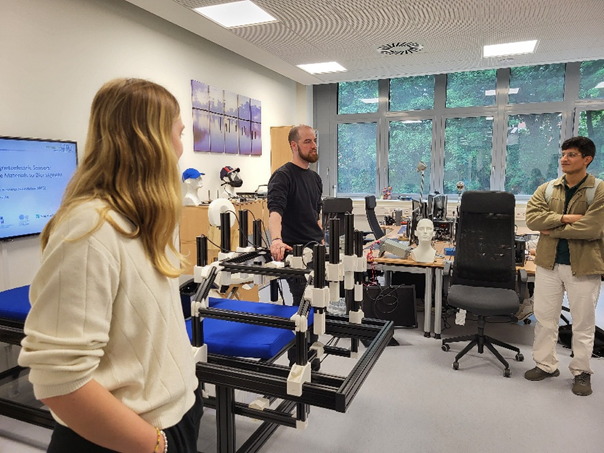
Felix Weisheit is showing us the cleanroom. He is a PhD student working with SAW- magnetic field sensors in project A9. Because his sensors are so small that even a single dust particle could destroy them, they must be fabricated in this ultra-clean environment. We are standing in front of the yellow room, where UV light, present in normal white light, is strictly avoided, as it would prematurely harden the photoresists he uses to pattern the structures on his devices.
Lucie Bangert is a doctoral researcher in the project B12 and taught us about the opportunities magnetoelectric sensors could have in the field of medicine. Her research involves testing magnetic nanoparticles in a special polymer matrix to detect inflammations or leakages in the gut after surgery. It was exciting to hear about her ambitions and her motivation for the upcoming work.
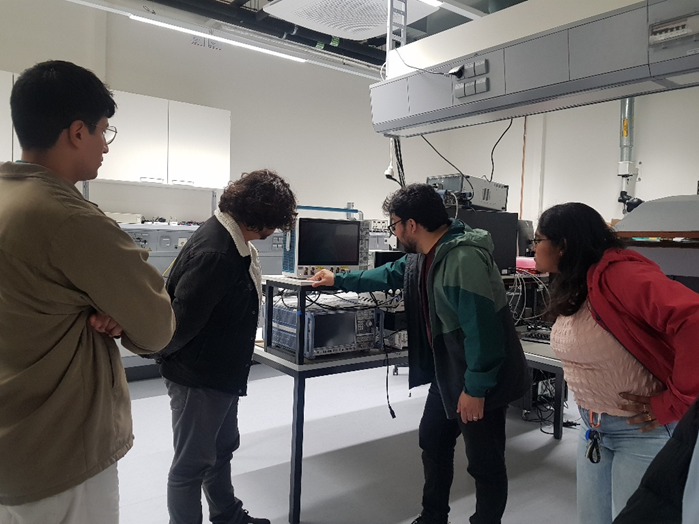 Doctoral researcher Johan Arbustini presented an overview of the hardware design and its noise performance evaluation. The design process integrates various simulation tools to demonstrate proof of concept for the signal processing system. To achieve the desired signal-to-noise ratio (SNR), the electronics are customized not only based on the sensing principle but also according to the specific application. Following the simulation phase, a hardware prototype is implemented using embedded micro-controllers and tested to evaluate performance across the target SNR and frequency range. To ensure the high-quality hardware performance the board prototype is built using application specific integrated circuits (ASICs) in combination field programmable gate arrays (FPGA). This presentation showed how integrated is the sensor development (A projects) with the applications (B projects).
Doctoral researcher Johan Arbustini presented an overview of the hardware design and its noise performance evaluation. The design process integrates various simulation tools to demonstrate proof of concept for the signal processing system. To achieve the desired signal-to-noise ratio (SNR), the electronics are customized not only based on the sensing principle but also according to the specific application. Following the simulation phase, a hardware prototype is implemented using embedded micro-controllers and tested to evaluate performance across the target SNR and frequency range. To ensure the high-quality hardware performance the board prototype is built using application specific integrated circuits (ASICs) in combination field programmable gate arrays (FPGA). This presentation showed how integrated is the sensor development (A projects) with the applications (B projects).
Unwinding with coffee and conversations:
After an information-packed day, we had the chance to unwind over coffee in the company of our onboarding coordinators and several doctoral researchers. It was a relaxed setting that encouraged conversation, reflection, and connection. As Otto Carlos Lippmann put it, “I believe the best part of the day was meeting new colleagues and having the opportunity to share both our work and some personal experiences. The friendly atmosphere and engaging discussions made the day enjoyable and fun.”
Many thanks to everyone who contributed to the planning and coordination of this informative day.
